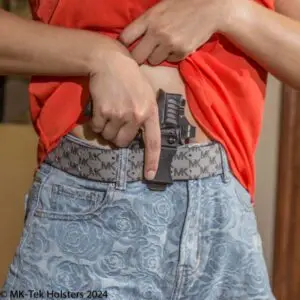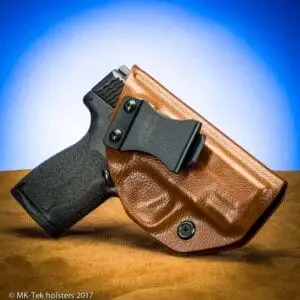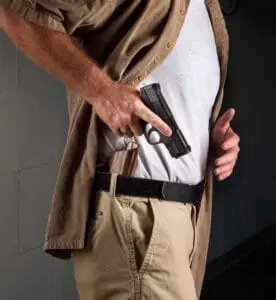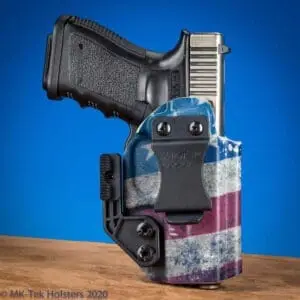A Guide for Responsible Concealed Carry
Carrying a firearm is a significant step in personal protection, and it’s not just about owning a handgun and strapping it on. Learn the Concealed Carry Basics. Concealed carry, whether with an IWB (inside-the-waistband) holster or another setup, is a lifestyle choice that requires knowledge, responsibility, and preparation. Here are five essential things to know before you carry, ensuring you’re equipped both mentally and physically for this serious responsibility.
1. Concealed Carry Laws Are Complex and Localized
Gun laws vary not only from state to state but sometimes even from city to city. Before you carry, it’s crucial to understand the specific concealed carry laws in your jurisdiction. Ignorance is not a defense if you inadvertently violate a regulation.
For instance, some states require a permit to carry concealed, while others allow permitless carry (commonly referred to as “constitutional carry”). Some areas may have restrictions on where you can carry, like schools, federal buildings, or private businesses. Crossing state lines adds another layer of complexity—reciprocity laws determine whether your permit is valid in another state.
Take the time to research local laws and consult reliable sources such as your state government’s website or firearm advocacy groups like USCCA or NRA-ILA. Apps like CCW Reciprocity Map & Gun Laws are also helpful for staying updated. Remember, as a responsible gun owner, staying compliant is part of your personal protection plan.
2. The Right Gear Makes All the Difference
Carrying concealed isn’t just about your handgun—it’s about how you carry it. Investing in quality gear, especially a holster, is crucial. A poorly made holster can lead to discomfort, printing (when the outline of your gun is visible), or even safety issues. Things to Know Before You Carry with the right gear.
An inside-the-waistband (IWB) holster is a popular choice for concealed carry because it offers excellent concealment 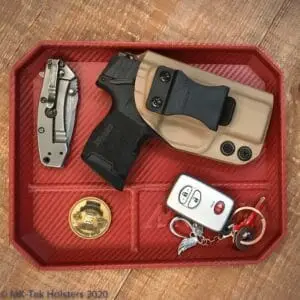 while keeping your firearm secure and accessible. Look for features like:
while keeping your firearm secure and accessible. Look for features like:
- Adjustable Retention: Ensures your gun stays securely in place.
- Durable Materials: Kydex or Boltaron are a top choice for its rigidity and reliability.
- Comfort: Sweat guards and smooth edges make a significant difference for all-day wear.
- Accessibility: If you can not get to your handgun it is not a good carry holster.
At MK-Tek Holsters, we design concealed carry holsters with both safety and comfort in mind. Whether you’re carrying a Glock, Sig Sauer, or another firearm, a well-designed holster ensures your carry experience is as seamless as possible.
3. Training Isn’t Optional—it’s a Lifelong Commitment
Owning a firearm doesn’t make you proficient with it. Carrying one requires consistent practice and training. This includes not only developing accuracy but also practicing safe handling, situational awareness, and decision-making under stress.
Here’s a breakdown of training essentials:
- Range Time: Practice shooting from different positions, distances, and lighting conditions. Check out local shooting ranges or nationally recognized ones like NRA’s Range Locator to find a training facility near you.
- Drawing from a Holster: Safely and efficiently drawing your firearm from an IWB holster is a skill that requires muscle memory. Organizations like Gunsite Academy and Sig Sauer Academy offer classes specifically focused on holster draw techniques.
- Scenario-Based Training: Consider attending courses that simulate real-world situations, such as those offered by Tactical Defense Institute (TDI) or Mas Ayoob Group.
- Legal Training: Understanding when and how you can legally use force is as important as knowing how to shoot. Programs like the USCCA’s Concealed Carry and Home Defense Fundamentals provide valuable legal overviews.
The goal isn’t just to be a good shot; it’s to be prepared, confident, and capable of handling your firearm responsibly in any situation.
4. Concealment Takes Planning and Practice
Carrying concealed means blending in. The last thing you want is for others to know you’re carrying—it defeats the purpose of concealed carry and can lead to uncomfortable or even dangerous situations.
To achieve effective concealment:
- Choose the Right Clothing: Opt for slightly looser clothing to avoid printing. Untucked shirts, jackets, or
 hoodies work well for most setups. Choose nondescript clothing that blends.
hoodies work well for most setups. Choose nondescript clothing that blends. - Test Holster Placement: Experiment with different carry positions, such as appendix (AIWB) or 3:30 o’clock, to find what works best for your body type. There are many things to know before you carry.
- Practice Daily Movements: Sitting, bending, or reaching can unintentionally expose your firearm. Practice these movements to ensure you stay concealed. Concealed Carry Basics are a starting point.
Additionally, carrying concealed is as much about mindset as it is about gear. You’ll need to develop situational awareness to avoid inadvertently drawing attention to yourself. Remember, the element of surprise is a key advantage in a defensive scenario.
5. Mental Preparedness Is as Important as Physical Readiness
Carrying a firearm is a tremendous responsibility. Beyond the mechanics of carrying and shooting, you must be mentally prepared for the weight of this decision.
Here are some key mental considerations:
- Understanding the Consequences: The decision to draw your firearm in a defensive situation is life-altering. It’s vital to understand the legal, emotional, and financial repercussions of using your weapon.
- De-escalation Skills: Carrying a gun doesn’t mean it’s your first solution. Often, avoiding or defusing a confrontation is the best outcome. Organizations like Brownells have many educational videos. offer training on conflict resolution and de-escalation techniques.
- Commitment to Responsibility: Carrying means being responsible at all times—no shortcuts, no negligence. For instance, storing your firearm safely at home or in your vehicle when not in use is non-negotiable.
The decision to carry isn’t just about protecting yourself; it’s about ensuring that your actions don’t endanger others unnecessarily. The more prepared you are mentally, the better equipped you’ll be to handle the enormous responsibility that comes with concealed carry.
Bonus Tip: Build a Community
While carrying concealed is a personal choice, you don’t have to go it alone. Concealed Carry Basics are learned in a community setting. Join a community of like-minded individuals who prioritize responsible gun ownership. Whether it’s a local gun club, online forum, or concealed carry class, engaging with others provides valuable insights, support, and encouragement.
At MK-Tek Holsters, we pride ourselves on being part of this community. We’re not just about making holsters; we’re about empowering individuals to carry confidently and responsibly.
Conclusion
Carrying a firearm for personal protection is a profound decision that comes with legal, moral, and practical responsibilities. By understanding the laws, investing in the right gear, committing to continuous training, practicing effective concealment, and preparing mentally, you’ll set yourself up for success as a responsible concealed carrier.
Things to Know Before You Carry on your journey to concealed carry starts with preparation and the right mindset. At MK-Tek Holsters, we’re here to support you every step of the way with high-quality holsters designed for real-life carry. Whether you need an IWB holster, a Glock holster, or simply expert advice, we’ve got your back.
Stay safe, stay prepared, and carry with confidence. The best handgun is the one you have with you.


